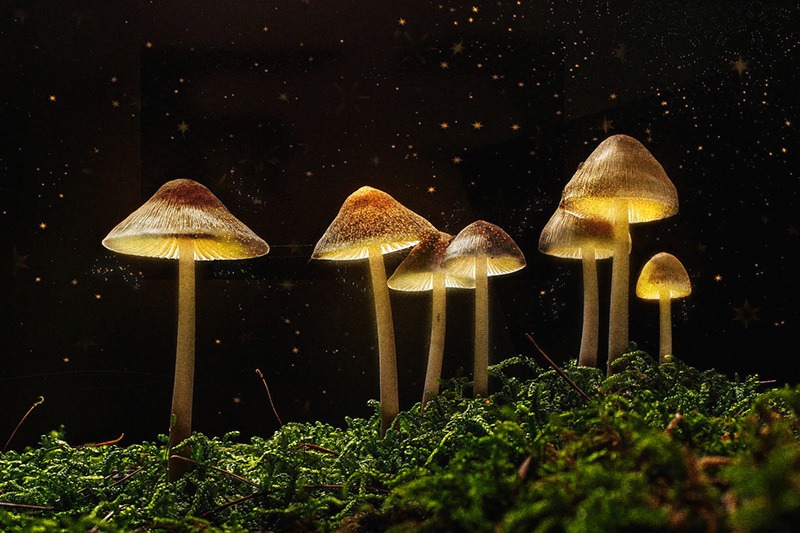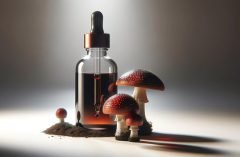Table of Contents
- 1 What Is Microdosing Magic Mushrooms?
- 2 The Potential Mental Health Benefits of Microdosing Magic Mushrooms
- 3 Improved Mood and Reduced Anxiety
- 4 Help for Stroke Patients?
- 5 How to Start Microdosing Magic Mushrooms Safely
- 6 Tips for Integrating Microdosing Into Your Routine
- 7 Microdosing Magic Mushrooms FAQ
- 8 Conclusion

What Is Microdosing Magic Mushrooms?
Microdosing refers to taking sub-perceptual doses of psychedelic substances, such as magic mushrooms or LSD, to improve creativity, mood, and cognition. With microdosing mushrooms, people consume tiny amounts – usually 0.1 to 0.3 grams of dried psilocybin mushrooms. This is about 1/10th of a typical recreational dose. At these levels, you should not experience any psychedelic effects.
How Microdosing Magic Mushrooms Works
Microdosing works by stimulating nerve cell growth in parts of the brain involved in memory, cognition, and neuroplasticity. Psilocybin in mushrooms acts on some of the same receptors in the brain that respond to the neurotransmitter serotonin. In microdoses, psilocybin may help forge new neural connections and stimulate the growth of dendrites – the branched extensions that allow neurons to communicate with each other.
Potential Benefits of Microdosing Mushrooms
Some potential benefits of microdosing mushrooms include:
- Improved mood and reduced symptoms of depression or anxiety. Microdosing may have antidepressant effects and help regulate emotions.
- Increased creativity. Microdosing may enhance divergent thinking, a component of creativity associated with generating new and original ideas.
- Better focus and concentration. Microdosing could stimulate increased blood flow to the prefrontal cortex, the area of the brain involved in focus, planning, and problem-solving.
- Improved relationships. Microdosing may increase empathy, compassion, and connection to others. Some people report improved communication and less social anxiety when microdosing.
With the proper precautions taken, microdosing magic mushrooms shows promise as a therapeutic tool for optimizing mood, cognition, creativity, and well-being. However, more research is still needed to fully understand the effects and long-term impact. Still, I’m about to begin my microdosing of psilocybin in magic mushrooms. A new Spinfuel Column concerning my journey will begin in May 2024.
The Potential Mental Health Benefits of Microdosing Magic Mushrooms
Microdosing psilocybin mushrooms has been shown to help improve various aspects of mental health and well-being. Studies indicate that microdoses of psilocybin may have antidepressant effects by increasing connectivity between different regions of the brain.
Improved Mood and Reduced Anxiety
Microdosing may help improve your mood and decrease feelings of anxiety or worry. Some research shows that psilocybin activates serotonin receptors in the brain which can lead to improved mood and optimism. Anecdotal reports from people who microdose often describe feeling more positive emotions and less anxiety.
Enhanced Creativity and Focus
Microdoses of psilocybin are thought to increase blood flow and connectivity in parts of the brain involved in creative thinking, abstract connections, and problem-solving. Many who microdose report experiencing enhanced focus, concentration, and flow states. Microdosing may also enhance your ability to make new neural connections, facilitating innovative thinking.
Insight and Self-Awareness
Microdosing psilocybin in a purposeful, reflective manner may increase feelings of insight and self-awareness. Some report gaining a broader perspective on themselves, their relationships, and their habits or thought patterns. With the support of journaling or therapy, microdosing may help foster personal growth and enhance your understanding of yourself.
Overall, microdosing psilocybin shows promise as a therapeutic tool and a pathway toward optimal mental well-being. When done with intention and care, microdosing may help alleviate symptoms of depression and anxiety, enhance your creativity, and promote insight into yourself and your relationships. However, more research is still needed to fully understand the effects and applications of microdosing.
Help for Stroke Patients?
There is limited research on the specific effects of microdosing psilocybin on stroke patients’ cognition. Most studies involving psilocybin and cognition focus on conditions like depression, anxiety, and PTSD.
However, some research suggests that psilocybin, even in small doses, may have neuroprotective and neuroregenerative effects. These effects could potentially be beneficial for stroke recovery, as they may support brain health and plasticity.
It’s essential to note that the use of psilocybin or any psychedelic substance for medical purposes should only be done under the supervision of a qualified healthcare professional. Further research is needed to understand the effects of microdosing psilocybin on stroke recovery specifically.
How to Start Microdosing Magic Mushrooms Safely
To begin microdosing safely, you must first obtain pure psilocybin mushrooms. Purchase spores or dried mushrooms from a reputable source and verify the correct species and strain. Once obtained, precisely measure a small dose according to your body weight. Begin with 1/10 to 1/20 of a typical recreational dose, around 0.1 to 0.5 grams of dried mushrooms. Consume the dose first thing in the morning, before any meals.
Test the Effects
For your initial doses, microdose on a day when you do not have work or other responsibilities. This allows you to gauge your sensitivity and monitor how you feel. The effects should be sub-perceptual, meaning you do not have overt hallucinations or feel intoxicated. If the effects are too strong, lower your dose for the next trial. Increase the amount slightly over time until you find your optimal dose. Always start low and go slow.
Develop a Schedule
Most individuals microdose with one day on, and two days off. An example schedule would be microdosing on Monday, Wednesday and Friday or Tuesday, Thursday and Saturday. The two off days allow your body to reset in between doses. Do not microdose more than 3 non-consecutive days per week. Continuously microdosing for long periods can lead to building up a tolerance.
Integrate Into Your Routine
On microdose days, continue with your typical routine. The key is to seamlessly incorporate the practice into your daily life. Note any cognitive, emotional or physical effects in a journal to determine if microdosing is benefitting you. Look for improvements in mood, focus, productivity, relationships, and general well-being. Microdosing is a personal experiment, so finding what works best for your unique situation will take time and practice. Always prioritize your health, safety, and legal standing above all else.
In summary, by starting low, gauging your sensitivity, developing a schedule, and closely monitoring the effects, you can safely begin a microdosing practice. Practiced responsibly, microdosing psilocybin mushrooms may have benefits for your mental well-being and personal growth. However, there are legal risks to consider before proceeding.
Tips for Integrating Microdosing Into Your Routine
Start Low and Go Slow
When first starting a microdosing regimen, begin with a very small amount of psilocybin mushrooms, around 0.1-0.3 grams. This helps you understand how it will affect you before increasing the dose. You can slowly build up the amount over time as needed. It is best to start on a day off from work or on a weekend when you have few responsibilities.
Find the Right Schedule
Most people find that microdosing 2-4 times per week, with 1-2 days off in between, works well. A popular schedule is to microdose on Mondays and Thursdays. The key is to find a routine that works with your own needs and lifestyle. You may need to adjust the schedule over time to optimize the benefits.
Observe How You Feel
Pay close attention to the effects of the microdose and any changes in your mood, thinking, and behavior on dose days. Keep notes in a journal about how you feel, any insights you gain, challenges you face, and benefits you observe. Look for both positive and negative effects. Adjusting the dose or schedule may be needed based on your observations.
Integrate New Practices
Microdosing is most effective when combined with other wellness practices like meditation, yoga, spending time in nature, journaling, and talk therapy. Try starting a new routine or hobby on your microdosing days to take advantage of the creative, insightful mindset that can emerge. Breaking old habits and establishing new neural pathways will have lasting benefits.
Take Care of Yourself
On microdosing days, be sure to nurture yourself by maintaining a healthy diet, limiting alcohol and caffeine, staying hydrated, and getting enough rest. Engage in social interaction and light exercise which can enhance the benefits. Your set and setting also matter, so create a positive environment where you feel at ease. With self-care and the right conditions, microdosing can have profoundly positive effects.
In summary, by starting low and slow, finding an optimal schedule, observing how you feel, integrating new practices, and taking good care of yourself, microdosing magic mushrooms can be safely and effectively integrated into your routine. With time and patience, you may experience lasting improvements in your mental well-being, creativity, and quality of life.
Microdosing Magic Mushrooms FAQ
1 – What exactly is microdosing magic mushrooms?
Microdosing refers to ingesting very small amounts of magic mushrooms, typically 0.1 to 0.3 grams of dried mushrooms. At these doses, the psychoactive effects are subtle and you can continue with your daily activities. The goal of microdosing is to improve mood, creativity, and productivity.
2 – How often should you microdose?
For the best results, most people follow a schedule of microdosing every third or fourth day. This helps prevent building up a tolerance while still gaining the benefits. It is not recommended to microdose every day. You should start with a low dose and see how it affects you before increasing the amount or frequency.
3 – What are the benefits of microdosing magic mushrooms?
Many people report improved mood and well-being, increased creativity, better focus, and higher productivity from microdosing mushrooms. Some studies have found psychedelics like mushrooms may help with depression, anxiety, and PTSD. However, research on the benefits of microdosing specifically is still limited. Effects seem to vary from person to person.
4 – Are there any risks or side effects?
When done responsibly, microdosing mushrooms appears to be relatively low-risk. However, possible side effects include anxiety, insomnia, restlessness and upset stomach. There is also a risk of a “bad trip” if you take slightly too much. Long term effects of regular microdosing are still unknown. Mushrooms may interact with some medications. You should always do plenty of research and consult a doctor before microdosing.
5 – How do you get started with microdosing magic mushrooms?
If you want to try microdosing mushrooms, start by researching the laws in your area and the risks involved. When you feel properly informed and prepared to do so safely and responsibly, you can obtain dried psilocybin mushrooms to measure out small microdoses. Start with a very low amount, around 0.1 grams. Take notes on how it affects your mood, focus, and productivity to find the optimal dose and schedule for you. Always put your health and safety first.
Conclusion
As we’ve explored, microdosing magic mushrooms, when done carefully and with intention, may offer a range of benefits related to mental wellness. While more research is still needed, preliminary studies and anecdotal reports suggest microdosing could potentially help reduce anxiety and depression, increase creativity and focus, and lead to personal insights. If you decide to try microdosing, be sure to educate yourself on proper protocols, potential risks, and legal considerations. Start low, go slow, and pay close attention to your mind and body. Microdosing is not a cure-all, but rather one tool you may choose to thoughtfully add to your wellness toolkit. Approach with care, patience, and optimism.





